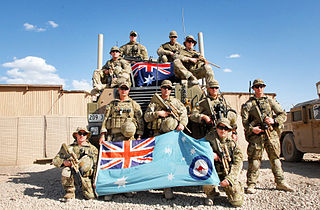
Airfield Defence Guards (ADG) are a mustering of the Royal Australian Air Force (RAAF) that are dedicated to the security and ground defence of airbases and other military aviation assets. Other duties include training other RAAF personnel, in skills such as the handling of small arms and infantry tactics. They do not, however, operate anti-aircraft artillery or missiles.

RAAF Base Richmond is a Royal Australian Air Force (RAAF) military air base located within the City of Hawkesbury, approximately 50 kilometres (31 mi) North-West of the Sydney Central Business District in New South Wales, Australia. Situated between the towns of Windsor and Richmond, the base is the oldest base in New South Wales and the second oldest in Australia. The base is home to the transport headquarters RAAF Air Lift Group, and its major operational formations, Nos. 84 and 86 Wings. The main aircraft type operated at the base is the Lockheed C-130 Hercules. Richmond is a regular venue for air shows and had at times been mooted as a site for Sydney's proposed second international airport.

The 380th Air Expeditionary Wing is a provisional unit of the United States Air Force Air Combat Command (ACC). It is attached to the United States Air Forces Central Command component of ACC and is stationed at Al Dhafra Air Base, United Arab Emirates.

RAAF Base Pearce is the main Royal Australian Air Force (RAAF) military air base in Western Australia, located in Bullsbrook, north of Perth. It is used for training by the RAAF and the Republic of Singapore Air Force.
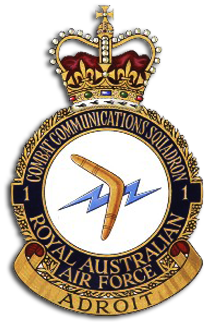
The Royal Australian Air Force's No. 1 Combat Communications Squadron (1CCS) is a squadron within No. 95 Wing and is responsible for the provision of expeditionary Communications and Information Systems (CIS) to support Air Force and Australian Defence Force operations and exercises.

The Royal Australian Air Force's Air Combat Group (ACG) is the group which administers the RAAF's fighter and bomber aircraft. ACG was formed on 7 February 2002 by merging the RAAF's Tactical Fighter Group and Strike Reconnaissance Group in an attempt to improve the speed with which the RAAF can deploy its combat aircraft.

No. 78 Wing is a Royal Australian Air Force (RAAF) operational training wing, headquartered at RAAF Base Williamtown, New South Wales. It comprises Nos. 76 and 79 Squadrons, operating the BAE Hawk 127 lead-in fighter, and No. 278 Squadron, a technical training unit. No. 79 Squadron, located at RAAF Base Pearce, Western Australia, is responsible for converting new pilots to fast jets, while No. 76 Squadron at Williamtown conducts introductory fighter courses; both units also fly support missions for the Royal Australian Navy and the Australian Army.

No. 81 Wing is responsible for operating the Lockheed Martin F-35 Lightning II multi-role fighters of the Royal Australian Air Force (RAAF). Headquartered at RAAF Base Williamtown, New South Wales, the wing comprises three combat units, Nos. 3 and 77 Squadrons based at Williamtown and No. 75 Squadron at RAAF Base Tindal, Northern Territory, as well as an operational conversion unit at Williamtown. No. 81 Wing headquarters oversees squadron training in air-to-air and air-to-ground tactics, and support for the Australian Army and Royal Australian Navy. Tasked with offensive and defensive counter-air operations, the Hornets have been deployed to Diego Garcia in 2001–02, when they provided local air defence, to Iraq in 2003, when they saw action flying fighter escort and close air support missions in concert with Coalition forces, and to the Middle East in 2015–16, when they undertook strike operations during the military intervention against ISIL. They have also been employed to patrol high-profile events in Australia, including the Commonwealth Games and visits by foreign dignitaries.

No. 396 Expeditionary Combat Support Wing is a ground support wing of the Royal Australian Air Force (RAAF). Part of the Combat Support Group, it is responsible for the provision of combat and base support services and maintains the RAAF's "bare bases" at Weipa, Exmouth and Derby in the northern part of Australia's airspace. The wing consists of three expeditionary combat support squadrons, one combat support squadron, an operations support squadron, a combat logistics squadron and two support units, which are located at various bases all around Australia, and in Malaysia at RMAF Butterworth.
The Airfield Defence Wing of the Royal Australian Air Force (RAAF) was formed to provide command and control of the RAAFs Airfield Defence Squadrons (AFDSs). Between the end of World War II and 1983, the RAAF did not possess a formed unit of ground defence specialists. No. 2 Airfield Defence Squadron (2AFDS) was reformed as the sole AFDS in 1983; however, following the introduction of the Ready Reserve scheme in 1992, No. 1 Airfield Defence Squadron (1AFDS) was reformed at RAAF Base Tindal, Northern Territory. The establishment of two squadrons led to the requirement for a parent headquarters to provide appropriate command and control, with AFDW being formed in 1994. No. 3 Airfield Defence Squadron was raised in 1996 as a further subordinate unit of AFDW. The wing was disbanded in 2006 and its function absorbed by No. 395 Expeditionary Combat Support Wing. 3AFDS was disbanded as part of the same process.
No. 17 Squadron (17SQN), formerly 322 Expeditionary Combat Support Squadron (322ECSS) is a Royal Australian Air Force (RAAF) ground support squadron based at RAAF Base Tindal near Katherine, Northern Territory. In addition to providing support services at RAAF Tindal, it also has responsibilities for the three RAAF bare bases: RAAF Scherger near Weipa, Queensland, RAAF Curtin near Derby, Western Australia and RAAF Learmonth near Exmouth, Western Australia; and the Delamere Air Weapons Range.
No. 23 Squadron of the Royal Australian Air Force (RAAF) is a non-flying base operations and training squadron headquartered at RAAF Base Amberley near Brisbane, Queensland. The squadron was formed in 1937 and saw action against the Japanese during World War II as a bomber squadron. Operating from Archerfield during the early stages of the war, the squadron undertook maritime patrols off Australia's east coast before converting to a dive-bomber role and taking part in the New Guinea campaign. Later in the war, the squadron converted to Liberator heavy bombers and flew missions against Japanese targets in the Netherlands East Indies. After the war, No. 23 Squadron was used to reform No. 6 Squadron and was then re-raised as a Citizens Air Force unit based in Brisbane. Until 1960, the squadron flew jet fighter aircraft before converting to a ground support role and now forms part of the RAAF's Combat Support Group.

Transport Flight (Japan) was a Royal Australian Air Force (RAAF) transport unit that operated in the aftermath of the Korean War. It was formed in March 1955 at Iwakuni, Japan, and equipped with three Douglas C-47 Dakotas and a CAC Wirraway. The flight's main duty was flying a regular courier service between Japan and South Korea in support of Commonwealth military units based on the peninsula. Transport Flight (Japan) ceased operations in June 1956 and disbanded in September that year.
No 27 Squadron RAAF is a Royal Australian Air Force (RAAF) reserve and ground support squadron located at RAAF Base Townsville, Queensland. The squadron was formed on 1 July 1981 to recruit and train RAAF reservists in the Townsville area and in July 2010 took on the additional role of providing support services to RAAF Base Townsville.
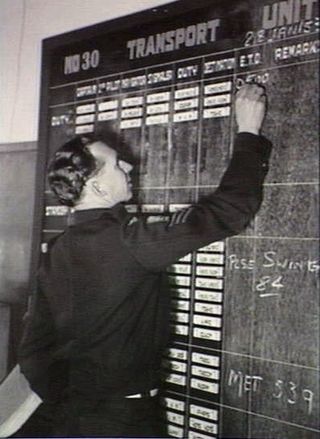
No. 30 Transport Unit was a Royal Australian Air Force (RAAF) unit that operated during the Korean War. It was formed in November 1950 as No. 30 Communications Unit and based at Iwakuni, Japan, as part of No. 91 (Composite) Wing. The unit was initially equipped with four Douglas C–47 Dakotas and two Austers, one of the Dakotas being the personal transport of Lieutenant General Sir Horace Robertson, commander of the British Commonwealth Occupation Force (BCOF). Another four Dakotas were sent to Japan due to operational demands. The unit's role in Korea was to support No. 77 (Fighter) Squadron by transporting supplies and equipment. It also delivered materials and stores to Australian and Commonwealth ground forces, and transported VIPs of the United Nations Command. Return journeys to Japan were often used to evacuate wounded personnel from the theatre. No. 30 Communications Unit was redesignated No. 30 Transport Unit in November 1951, and re-formed as No. 36 (Transport) Squadron in March 1953. The squadron remained in Korea following the armistice, and returned to Australia in June 1955.

RAAF Base Amberley is a Royal Australian Air Force (RAAF) military airbase located 8 km (5.0 mi) southwest of Ipswich, Queensland in Australia and 50 km (31 mi) southwest of Brisbane CBD. It is currently home to No. 1 Squadron, No. 6 Squadron, No. 33 Squadron, No. 35 Squadron and No. 36 Squadron. Amberley is also home to Army units making up the 9th Force Support Battalion. Located on 1,600 hectares, RAAF Amberley is the largest operational base in the RAAF, employing over 5,000 uniformed and civilian personnel. There are a variety of other formations on the base such as training colleges and maintenance areas. Amberley's largest squadron in terms of personnel is No. 382 Expeditionary Combat Support Squadron RAAF (ECSS) providing both garrison and deployed combat support. Amberley was one of only two airfields in Australia that were listed as a Transoceanic Abort (TOA) landing site for the Space Shuttle. Amberley is currently undergoing a A$64 million dollar re-development program. The RAAF has plans to have Amberley operating as its "superbase" with flights of F/A-18F Super Hornets, KC-30A, C-17 Globemaster and the C-27J Spartan.
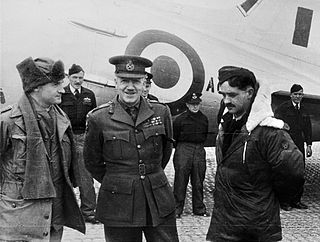
No. 91 (Composite) Wing was a Royal Australian Air Force (RAAF) wing that operated during the Korean War and its immediate aftermath. It was established in October 1950 to administer RAAF units deployed in the conflict: No. 77 (Fighter) Squadron, flying North American P-51 Mustangs; No. 30 Communications Flight, flying Austers and Douglas C-47 Dakotas; No. 391 (Base) Squadron; and No. 491 (Maintenance) Squadron. The wing was headquartered at Iwakuni, Japan, as were its subordinate units with the exception of No. 77 Squadron, which was based in Korea and came under the operational control of the United States Fifth Air Force.
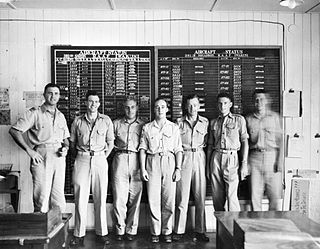
No. 391 (Base) Squadron was a Royal Australian Air Force (RAAF) squadron that operated during the Korean War and its immediate aftermath. It was established in October 1950 as part of No. 91 (Composite) Wing, which administered RAAF units deployed in the conflict. Apart from No. 391 Squadron, these included No. 77 (Fighter) Squadron, No. 30 Communications Unit, and No. 491 (Maintenance) Squadron. No. 391 Squadron was headquartered at Iwakuni, Japan, as were No. 91 Wing's other components with the exception of No. 77 Squadron, which was located on the Korean peninsula. The base squadron was responsible for administrative, logistical, medical, communications and security functions at Iwakuni, and also maintained detachments in South Korea. It included a marine section for harbour patrols and search-and-rescue in the waters off southern Japan. No. 391 Squadron was disbanded at the same time as No. 91 Wing headquarters, in April 1955.

No. 491 (Maintenance) Squadron was a Royal Australian Air Force (RAAF) squadron that operated during the Korean War and its immediate aftermath. It was unusual in that it was never based in Australia, being formed and dissolved in Japan. The squadron was established in October 1950 as part of No. 91 (Composite) Wing, which administered all RAAF units deployed as part of Australia's involvement in the Korean War. Apart from No. 491 Squadron, these included No. 77 (Fighter) Squadron, No. 30 Communications Unit, and No. 391 (Base) Squadron. No. 77 Squadron was based on the Korean peninsula, while No. 491 Squadron and No. 91 Wing's other components were headquartered at Iwakuni, Japan. The maintenance squadron was responsible for the upkeep of all No. 91 Wing aircraft at Iwakuni, and a section was attached to No. 77 Squadron in South Korea to assist with day-to-day servicing. No. 491 Squadron was disbanded in December 1954.














